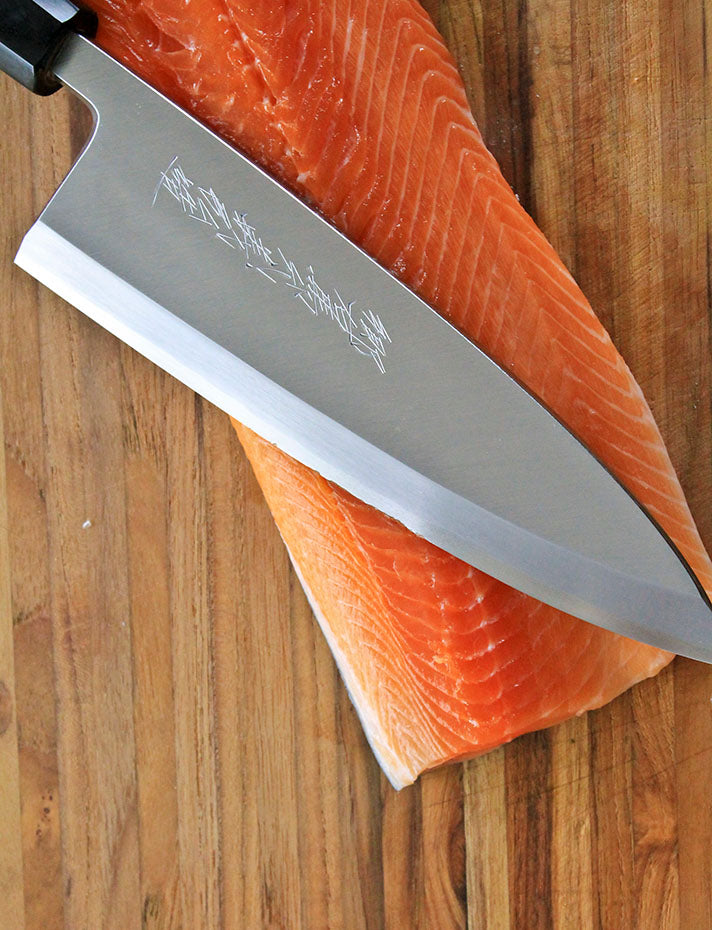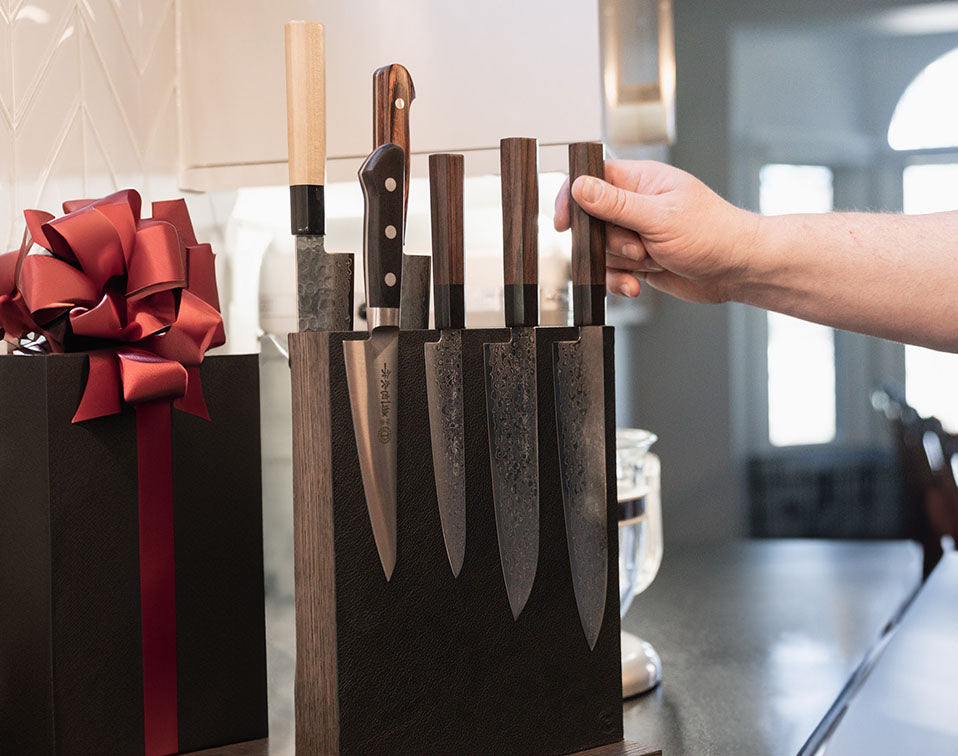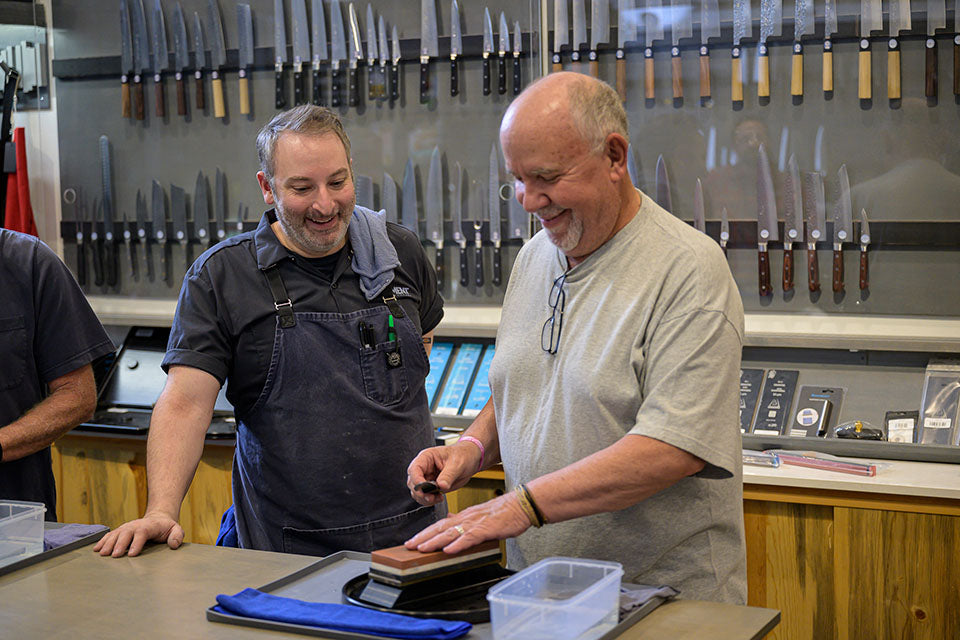German Vs Japanese Cutlery

German Vs Japanese Cutlery
Cultural Differences
For centuries, Japan and Germany have been recognized globally for producing the best knives. Their knife-forging processes' rich history and origins come from sword smithing centuries ago. Broadly, we're grouping Western makers (including French, American, and European knives) with German cutlery since their styles and attributes closely match German designs. Naturally, there are similarities and parallels between them. For instance, knives are forged and shaped, then heat treated. Nevertheless, there are distinct differences in handle materials and styles, alloys, blade shapes, and even philosophies.
German and Western sensibilities value versatility and durability. Subsequently, they created blade designs that offer a broader range of functionality and are typically more stout (thicker and weightier blades). Japan has undoubtedly influenced German knife makers. Today, most, if not all, German knife brands offer Japanese designs, series, or even sub-brands. In-kind, most Japanese knife makers offer designs that the West influences.
In Japan, the use of single-bevel knives in professional kitchens has a deep-rooted history and continues to this day. These task-specific, single-edged knives reflect the Japanese belief in using one tool for one job, leading to the creation of several types of knives for specific items such as eel, tuna, octopus, fugu, beef, chicken, etc. In contrast, double-bevel knives offer more versatility in their shape and design.
Presently, knife makers, whether German or Japanese, have been influenced by one another. You will find that most German brands have designs or even an entire series of Japanese-inspired cutlery. Conversely, most Japanese knife makers have designs or complete series with Western influences. This means that the comparison line between Japanese and German Cutlery is blurred. This is a good thing, especially in conjunction with how good modern metallurgy has become. Knives produced by credible manufacturers are a pleasure to use, making cooking a joy rather than a chore. A well-crafted artisan-built knife that is properly cared for will last a lifetime and can be passed down to future generations.
German Vs Japanese Cutlery
Thickness, Weight, & Balance
German
German cutlery typically has thicker blades with full tang handles. Full tang handles are commonly constructed with a metal bolster and metal connecting pins. This all adds up, making the knife heavier than Japanese knives. Thicker blade designs accommodate durability. Also, a thicker blade means that the knife will be more forward-heavy.
Japanese
Japanese knives are thinner, making them lighter in weight. Japanese bladesmiths also forge into the blade called the 'sweet point.' This is a balance spot 1/3 down from the tip where the blade feels balanced while in motion, allowing the knife to become an extension of your hand. The user gains better control and experiences less fatigue.
German Vs Japanese Cutlery
Handles
German
Handle designs for German knives are full-tang. This means a single piece of steel is used to make the blade and becomes the center of the handle, running all the way to the butt. The tang can be seen since it is the same shape as the handle silhouette. Classically, a bolster is forged, and often it tapers downward into a finger guard at the heel of the knife. The handle scales (handle material on each side) are affixed to the tang with metal pins. The metal pins, metal bolster, and full tang design, along with thicker blades, make for an overall weightier knife.
Japanese
Traditionally, Japanese handles are oval, teardrop, or octagon in shape and have a hidden tang. This means a single piece of steel is used to make the blade and becomes the center of the handle, tapering, then stopping shy of the butt of the handle. Hidden-tang handles usually have a ferrule made from horn. This tapered and hidden tang design is another reason Japanese blades are often lighter in weight. In the modern day, Western handles are frequently used. Today, Japanese-made & designed Western handles often include a metal bolster, following German design cues. This bolster does not taper down into a finger guard at the heel like most German designs.
German Vs Japanese Cutlery
Hardness
German
German steel used for cutlery usually ranges from 57 to 59 on the HRC Rockwell Scale. Within this range of hardness, the knife's blade will have more forgiveness. This means less chipping while maintaining good edge retention.
Japanese
Commonly, Japanese alloys are harder. Typically ranging from 59 to 67 on the HRC Rockwell scale. Hard translates to better edge retention, but hard also means more brittle. It’s important that Japanese knives are not mistreated (like trying to open coconuts or chopping through bones).
German Vs Japanese Cutlery
Forging Construction
German
German knives are mono steel, which means the knife is hammered to shape from a single billet (solid length of metal, square or round cross-section of steel). The alloys have natural earth elements that give the knife characteristics. Features such as hardness, toughness, edge retention, sharpenability, etc. Once the knife has been shaped, it is quenched and then heat treated.
Japanese
Because Japanese steels are hard, it is important that the knife’s blade have shock absorption and structural integrity. Otherwise, hard steel alone would be very brittle. The answer to this challenge is to use hard steel for the cutting edge and soft steel at the spine and sides. This has created classic forging & heat-treating techniques such as Sanmai, Honyaki, Kasumiyaki, and Warikomi.
German Vs Japanese Cutlery
Alloys
German
Solingen city in Germany is world famous and has a long history associated with the production of premier knives and cutlery. With the advent of stainless steel circa the early 1900s and popularity gained in the late seventies, most German knives are constructed from stainless alloys today. Popular German alloys are MA5 steel, X50CrMoV15 steel, and 420 steel.
Japanese
Before the invention of stainless steel and the advancement of modern metallurgy, knives were made of high-carbon steel. Simply, Iron and Carbon. Today, Japanese companies like Hitachi & The Aichi Corporation, among others, produce high-carbon alloys or stainless alloys. These are used by Japanese manufacturers and blade smiths. Sometimes Japanese smiths break from tradition and use western alloys.
German Vs Japanese Cutlery
Blade Shapes And Designs
German
As mentioned earlier, German sensibilities value durability and versatility. Of course, there are particular types of knives that are category specific such as boning knives, but not necessarily task specific such as with the Japanese designs. Overall, the silhouette or profile of German knife blades have more ‘curve’ or ‘belly’ compared to their Japanese counterparts. Slicing, dicing, and chopping techniques utilize a rocking motion. Blade designs, in general, are more versatile. German blades are also typically thicker and are sharpened at 18° to 20°. These blades are a generally flat grind, meaning that there is a distal taper starting at the spine down to the cutting edge. It’s commonplace for German knives to have scallops on the side of certain blade designs. These are called ‘Kullenschliff’or ‘Granton,’ and they keep food products from sticking to the blade surface. Serrated knives, such as bread knives and utility knives, are more common in German designs.
Japanese
Unlike Japanese cutlery which offers different blade surface finishes and polishes, traditional German knives typically have a medium polish. Meaning the blades have a refined, smooth, & shiny surface, but not so shiny that they have a mirror polish. A German knife will have up to 40 steps in their production with finish polishing, sharpening, and honing being the last.
German Vs Japanese Cutlery
Blade Finishes
German
Unlike Japanese cutlery which offers different blade surface finishes and polishes, traditional German knives typically have a medium polish. Meaning the blades have a refined, smooth, & shiny surface, but not so shiny that they have a mirror polish. A German knife will have up to 40 steps in their production with finish polishing, sharpening, and honing being the last.
Japanese
Japanese bladesmiths have developed different finishes over the centuries. Migaki is a smooth polished finish that can range from brushed to mirror polish. A Nashiji finish, literally “pear skin,” has a light grit texture, giving the blade a rustic quality. Kurouchi, “the bladesmith’s finish,” is a technique in which black iron oxide is left on the blade from the forging process, ultimately helping to protect high- carbon from rust. Tsuchime, “hammered” is a texture on the blade from hammer marks. This callback to ancient handcrafting techniques helps prevent food products from clinging to the knife.
Learn Center
- Choosing a selection results in a full page refresh.
!













































